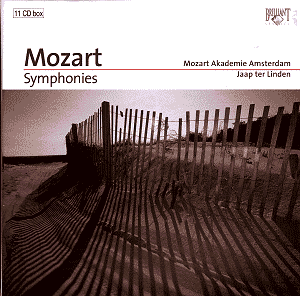



AVAILABILITY
Wolfgang
Amadeus MOZART (1756 - 1791)
Symphonies ("complete"):
Symphony No. 1 in Eb, K16 (1762)
Symphony No. 4 in D, K19 (1764)
Symphony in F, K19a (1764)
Symphony No. 5 in Bb, K22 (1765)
Symphony No. 6 in F, K43 (1767)
Symphony [No.7] in D, K45 (1768) (mis-identified as "#45")
Symphony No. 8 in D, K48 (1768)
Symphony No. 9 in C, K73 (1771)
Symphony No. 10 in G, K74 (1770)
Symphony No. 12 in G, K110 (1770)
Symphony in D, K111a "Ascanio in Alba" (1771)
Symphony No. 13 in F, K112 (1771)
Symphony No. 14 in A, K114 (1772)
Symphony No. 15 in G, K124 (1772)
Symphony No. 16 in C, K128 (1772)
Symphony No. 17 in G, K129 (1772)
Symphony No.18 in F K.130 (1772)
Symphony No. 19 in Eb (1772)
Symphony No. 20 in D, K133 (1772)
Symphony No. 21 in A, K134 (1772)
Symphony No. 22 in C, K162 (1773)
Symphony No. 23 in D, K181 (1773)
Symphony No. 24 in Bb K182 (1773)
Symphony No. 25 in g, K183 (1773)
Symphony No. 26 in Eb K.184 (1773)
Symphony in D K 196 "Finta Giardiniera" (1774)
Symphony No. 27 in G, K199 (1773)
Symphony No. 28 in C, K202 (1774)
Symphony No. 29 in A K.201 (1774)
Symphony No. 31 in D K.297 "Paris" (1778)
Symphony No. 32 in G K.318 (1779)
Symphony No. 33 in Bb, K319 (1779)
Symphony No. 34 in C K.338 (1780)
Symphony No. 35 in D K.385 "Haffner" (1782)
Symphony No. 36 in C K.425 "Linz" (1783)
Symphony No. 38 in D K.504 "Prague" (1786)
Symphony No. 39 in Eb K.543 (1788)
Symphony No. 40 in g K.550 First version without clarinets (1788)
Symphony No. 40 in g K.550 Second version with clarinets (1788)
Symphony No. 41 in C Major K.551 "Jupiter"(1788)
![]() Mozart Akademie Amsterdam/Jaap
ter Linden
Mozart Akademie Amsterdam/Jaap
ter Linden
Recorded at Maria Minor, Utrecht, Netherlands, 5 2002 (K111a, K.130 -
K.551),
and at Doopsgezinde Kerk, Haarlem, Netherlands, 2001. (K.16 - K110, K112
- K.202)
24 pages of notes in English. Photos of performers.
![]() BRILLIANT CLASSICS 92110/01-11
[11CDs: 733.41]
BRILLIANT CLASSICS 92110/01-11
[11CDs: 733.41]
Comparison recordings:
Erich Leinsdorf, RPO ("complete") [8CDs] [AAD/ADD mono/stereo]
Universal
Erich Leinsdorff, Rochester PO #41, K551 [mono] CBS LP
Hermann Scherchen, Champs Elysées Orch. K550/551 [mono] TAHRA TAH
154
Fritz Reiner, CSO #41, K551 BMG/RCA Red Seal 6376-2-RC
Rafael Kubelik, CSO #38, K504 [mono] Mercury Living Presence 434 387-2